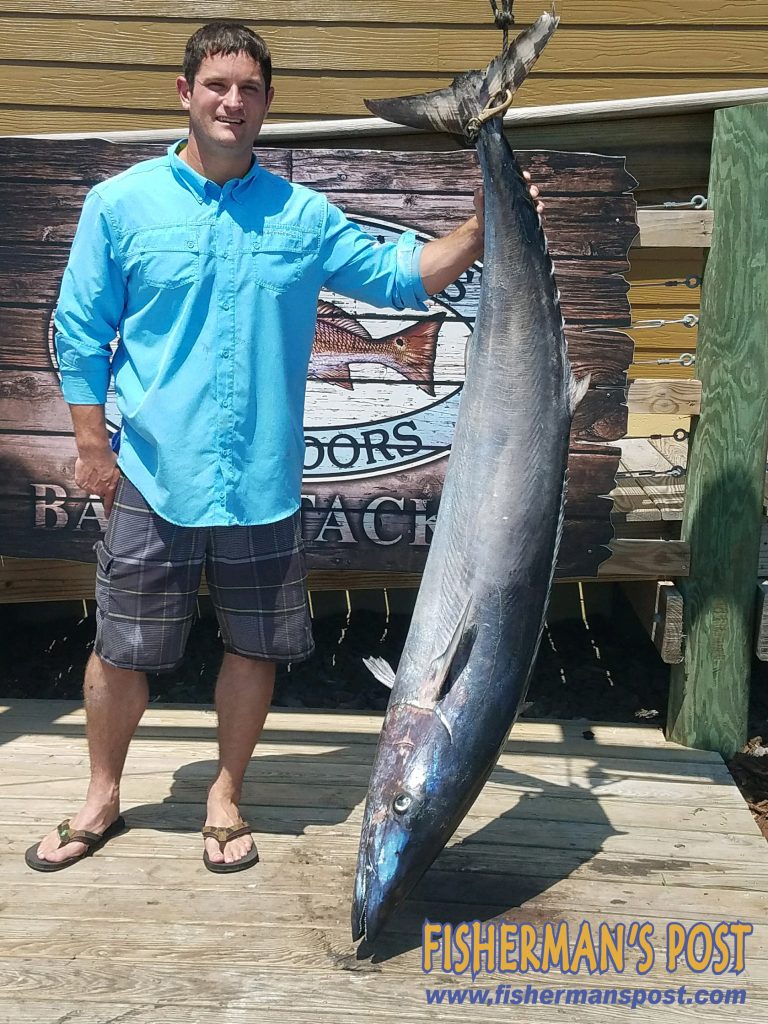Swansboro – June 22, 2017
James, of Reel Outdoors, reports that fishing the surf has produced pompano, blues, and spanish. Sand fleas have worked best for the pompano, while throwing Gotcha plugs and Stingsilvers has produced the blues and spanish.
Inshore anglers have had luck landing good numbers of sheepshead around the Swansboro and Emerald Isle bridge pilings. Most fish have fallen for fiddler crabs. Red and black drum have been mixed together around docks and oyster structure in the waterway. Fresh shrimp has worked for the black drum, while live mud minnows on Carolina rigs has been best for the reds.
Speckled trout fishing with live shrimp has produced limits of fish when targeting marsh lines and mud banks, and some citation-sized trout have been landed while working topwater plugs near the flats early in the morning.
Just off the beach, large spanish have shown up and have been willing to take trolled Drone spoons or Clarkspoons. Some of the spanish have pushed the 4-8 lb. range.

Ray Myers; of Jacksonville NC, with a 102 lb. wahoo caught on a Blue Water Cady “Hoo-Da-Bomb” with a cigar minnow at the Big Rock.
Sharks are feeding nearshore around area reefs and in the surf zone. Anglers drifting with cut baits have hooked in to plenty of shark action. The cobia bite has slowed down from weeks past, but a few are still being caught while fishing dead menhaden on the bottom.
Offshore in the Big Rock area, many anglers are still finding success with mahi and wahoo. Trolling skirted and naked ballyhoo has worked best for them. Those trying to land billfish are still finding blue marlin scattered in the area.
Matt, of Pogies Fishing Center, reports that the redfish have been scattered, but those throwing topwaters in the morning or fishing live mullet on Carolina rigs have connected with limits of reds. When using live mullet, anglers have also landed a few keeper flounder, but most fish have been short. Using live fiddler crabs around area bridges and docks with barnacle structure has produced high numbers of sheepshead and black drum. Most sheepshead and black drum have been keepers, and some have been as large as 5 lbs.
Nearshore fishing around the artificial reefs has produced good numbers of keeper flounder when tossing 2 oz. bucktails tipped with Gulp shrimp. Spanish have also been just off the beach. Trolling Clarkspoons has produced good numbers of fish, while drifting live menhaden has landed anglers fish in the 3-6 lb. range.
Around the 8 mile range, small kings in the 5-10 lb. class have been plentiful. Most fish are biting menhaden.

Allyson Kerr, with a 39 lb cobia caught using live bait in the Bouge sound, she was fishing on the boat “Ally-Reb”
Rob, of Sandbar Safari Charters, reports that redfish have been abundant all over the area, but they have been more scattered in the marsh and waterway. Targeting fish with topwater plugs in the morning has been successful, and as the sun comes up, live shrimp and mullet have done the trick. Most fish have been in the 18-21” range, but small pockets of upper to over-slot fish have been found as well. Gulp shrimp and jerk shads have also gotten the reds to bite.
Flounder have been mixed in the same areas, and anglers fishing live mullet or shrimp on Carolina rigs have been hooking in to a few fish per day. Most fish have been in the 16-20” range. Flounder around the nearshore reefs are a bit more spread out, but anglers willing to pick through short fish can find a few to put in the box.
Sheepshead and black drum have made their way from the area bridges to nearby oyster and dock structure. Live shrimp and fiddler crabs will get the job done, but live shrimp has been the preference.
Nearshore, spanish and kings are feeding in the 2-10 mile range. Most fish are falling for live menhaden, but some will take trolled spoons.
Johnathan, of On Point Charters, reports that red drum fishing in the area marshes and rivers has provided anglers with tons of action. Fishing cut menhaden or live finger mullet on Carolina rigs has been the best way to tempt the reds to bite. Float rigs have also worked well when targeting shallower areas with underwater structure.
Sheepshead have been feeding under the local bridges. Fiddler crabs dropped down on Carolina rigs have proven to be the best way to target these fish.
Nearshore, flounder fishing around the wrecks and ledges within 5 miles of the beach has boxed a few keeper fish each day. Most fish are falling for bucktails tipped with Gulp soft plastics.
Anywhere from just off the beach to the 10 mile range, larger spanish and kings (to 10 lbs.) have been feeding on live menhaden rigged on king rigs. Most fish are hanging around nearshore structure.
Bobby, of Teezher Charters, reports that the nearshore reefs have been holding smaller kings and spanish of mixed sizes. Most kings have been between 5-12 lbs., and the spanish have ranged from 3-5 lbs. Fishing with live menhaden on light wire and #3 trebles has produced the most bites.
Flounder have also been feeding around AR-330 and Station Rock, and they have been willing to hit Spro bucktails tipped with Gulps. Sharks and amberjacks are feeding around nearshore structure, too. A few cobia have been landed nearshore, but the majority of these fish have left the area.
Bottom fishing in the 60-80′ range has produced black sea bass and grouper, but many fish this close in have been short. Out to the 130-160′ range, anglers are finding the keeper-sized black sea bass, grouper, and snapper.
Trips to the Gulf Stream have produced some small and gaffer-sized dolphin. Sailfish, blackfins, and wahoo have also been in the mix and willing to take trolled ballyhoo and Blue Water Candy sea witches. Blue marlin are still around, and Ilander lures have been the ticket for them.
Traci, of Bogue Inlet Pier, reports that bluefish and spanish have been hitting Gotcha plugs tossed from the pier. Anglers electing to fish the bottom with shrimp have landed good catches of sea mullet and spots.





